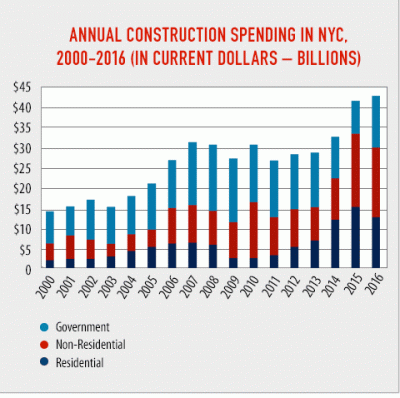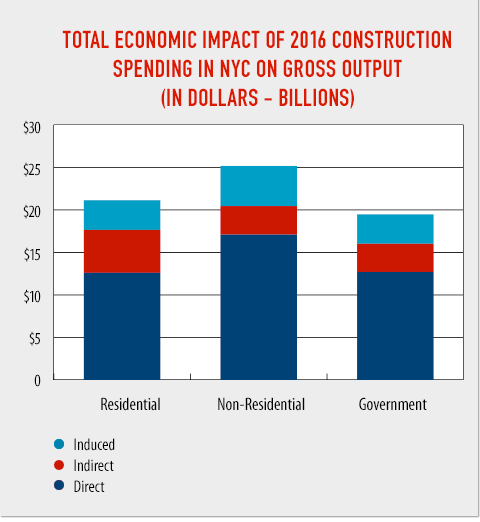
NYC construction industry produced $42 billion in spending and $66 billion in economic output in 2016
Ripple Effects Felt throughout the Five Boroughs
 |
|
| Sources: Dodge Data & Analytics, Public Agency Capital Budget/Plans, & Urbanomics |
Construction spending across the five boroughs set an all-time record in 2016 and also reached its highest annual level in decades, even after adjusting for inflation, according to a New York Building Congress analysis of multiple data sources.
The Building Congress estimates that a total of $42.4 billion was spent on construction projects in New York City last year, up from $41.2 billion in direct construction spending in 2015 and $32.4 billion in 2014. After adjusting for inflation, 2016 spending topped this century's previous high-water mark, set in 2007, by about 1 percent.
The Building Congress also analyzed the extent to which the current building boom continues to reverberate throughout the local economy. The $42.4 billion spent on direct construction last year generated an estimated $66.3 billion in total economic output, up from $64.9 billion in 2015 and $51.5 billion in 2014.
Of the $66.3 billion in total economic output in 2016, the Building Congress attributes $12.1 billion to the indirect impact of construction, which includes all employment and income generated by businesses that service the industry, such as architectural, engineering, legal and other firms. Another $11.8 billion is attributable to the induced impact of construction, which is the result of workers and suppliers spending their wages on local consumer purchases, such as clothing, food, and transportation.
This represents a multiplier effect of $1.56, as each dollar spent on
construction yielded an additional $.56 in overall economic activity.
Construction also played a role in the creation of nearly 349,000
local jobs in 2016. In addition to the 208,000 men and women employed
directly by the design, engineering and construction industry, last
year's activity produced another 141,000 jobs throughout New York City's
economy. Approximately 70,000 jobs were created in fields that service
the construction industry, such as lawyers, accountants, and suppliers.
Still another 71,000 jobs were induced by the increased household
earnings that resulted from direct construction and the related
expansion of economic activity.
"The construction industry continued to fire on all cylinders in 2016, which has extremely positive short- and long-term implications for New York City and the region," said New York Building Congress President and CEO Carlo A. Scissura. "In addition to being a catalyst for jobs, tax revenues, and heightened quality of life, a thriving construction industry generates enormous ripple effects that are felt by residents throughout the five boroughs and sows the seeds for continued economic growth."
 |
|
| Sources: Implan Pro Model for NYC & Urbanomics |
Non-Residential
Non-residential construction, which includes office space,
institutional development, sports/entertainment venues, and hotels,
produced the most in direct spending and economic output last year.
Activity in this sector led to a total 2016 economic output of $25.2
billion, including $17.1 billion from direct spending, $3.4 billion of
indirect output, and $4.7 billion from induced effects. This sector
produced $17.9 billion in direct construction spending and $26.3 billion
in total economic output in 2015. In 2014, non-residential construction
was responsible for $10.1 billion in direct spending and $14.9 billion
in economic output.
Government
Government construction spending, which includes investments in mass
transit, roads, bridges, and other essential infrastructure, reached
$12.7 billion last year, up from $8.1 billion in 2015 and $10.3 billion
in 2014. Last year's spending stimulated $3.3 billion in indirect and
$3.5 billion in induced output for a total economic impact of $19.5
billion, which is up from $12.5 billion in 2015 and $15.9 billion in
2014.
Residential
Residential construction yielded $12.6 billion in direct spending and
$21.6 billion in economic output in 2016, down from $15.2 billion and
$26.1 billion in 2015. In 2014, the residential sector accounted for
$12.0 in direct construction spending and $20.7 billion in economic
output. Prior to 2014, residential spending had never reached $7 billion
in any single year.
Mr. Scissura added, "The numbers confirm what we've been hearing from our members - the current building boom is being driven by all three main construction sectors, which is really important. It means that there's a lot of work available for all industry firms and tradespeople, no matter their specialty. Just as importantly, it indicates that the builders of housing and infrastructure are working to keep pace with the growing demands of the city's businesses and residents."
Dodge data used for this analysis can be purchased at dodge.construction.com.



